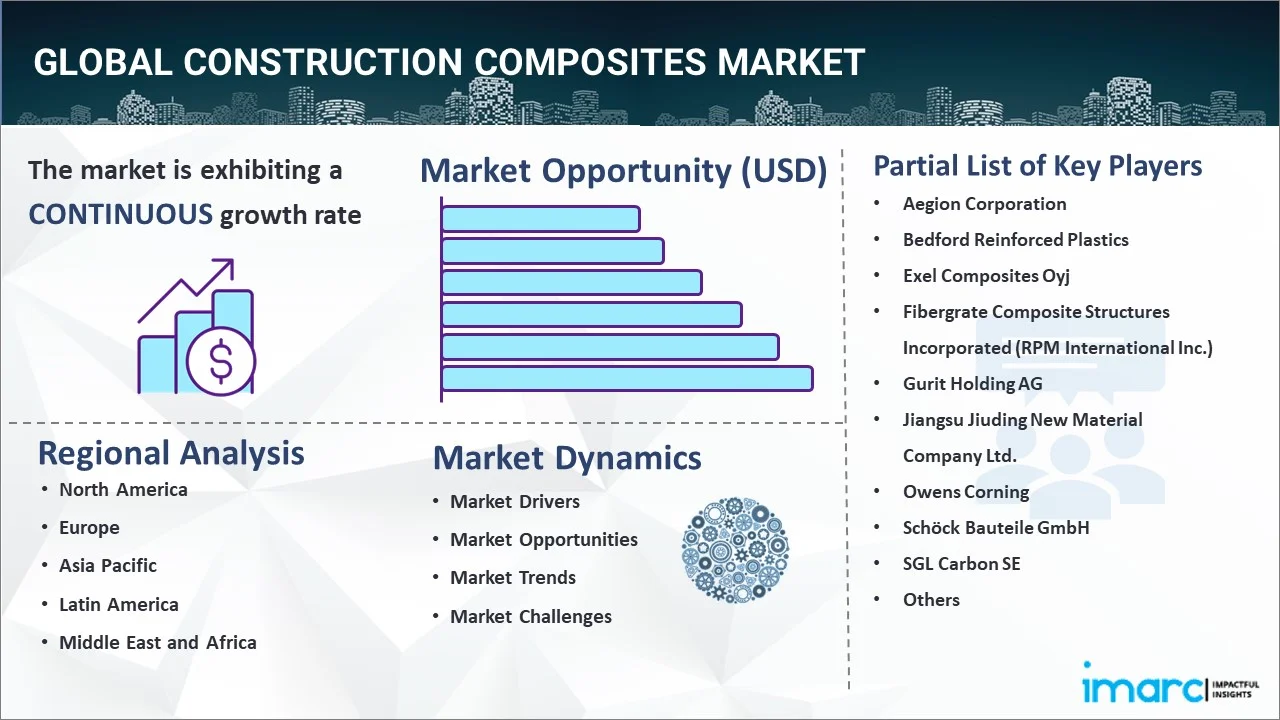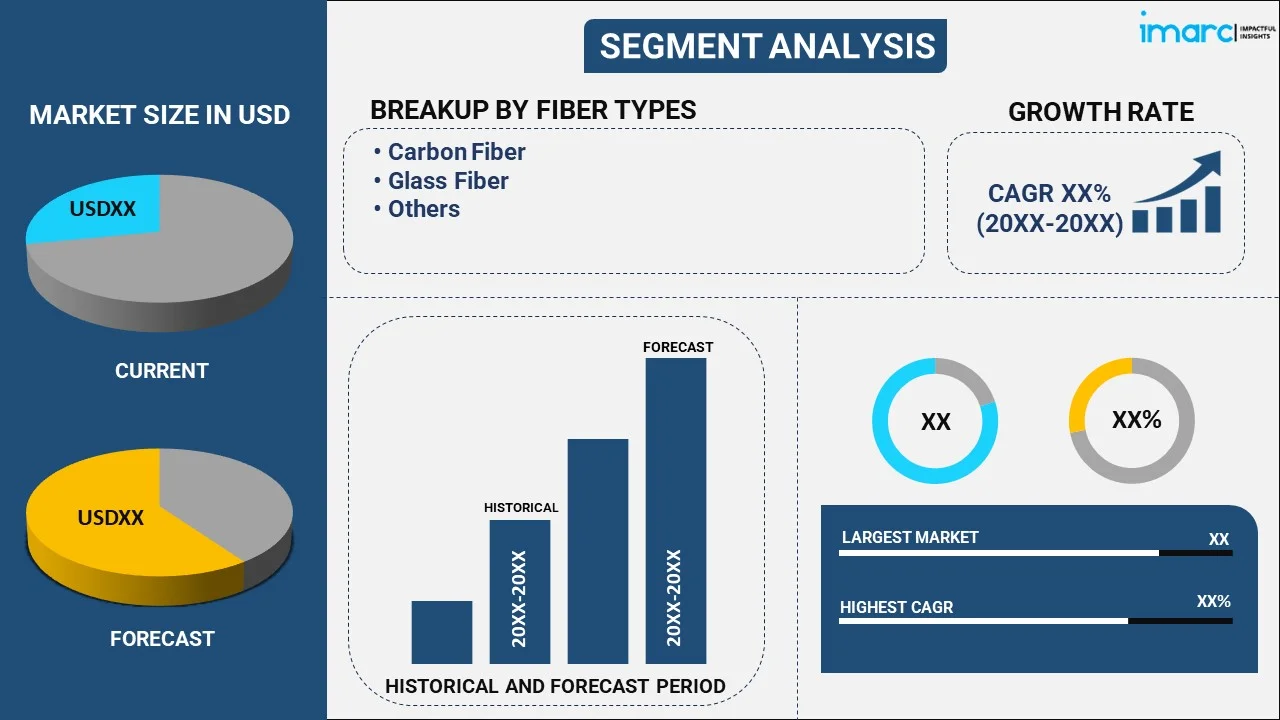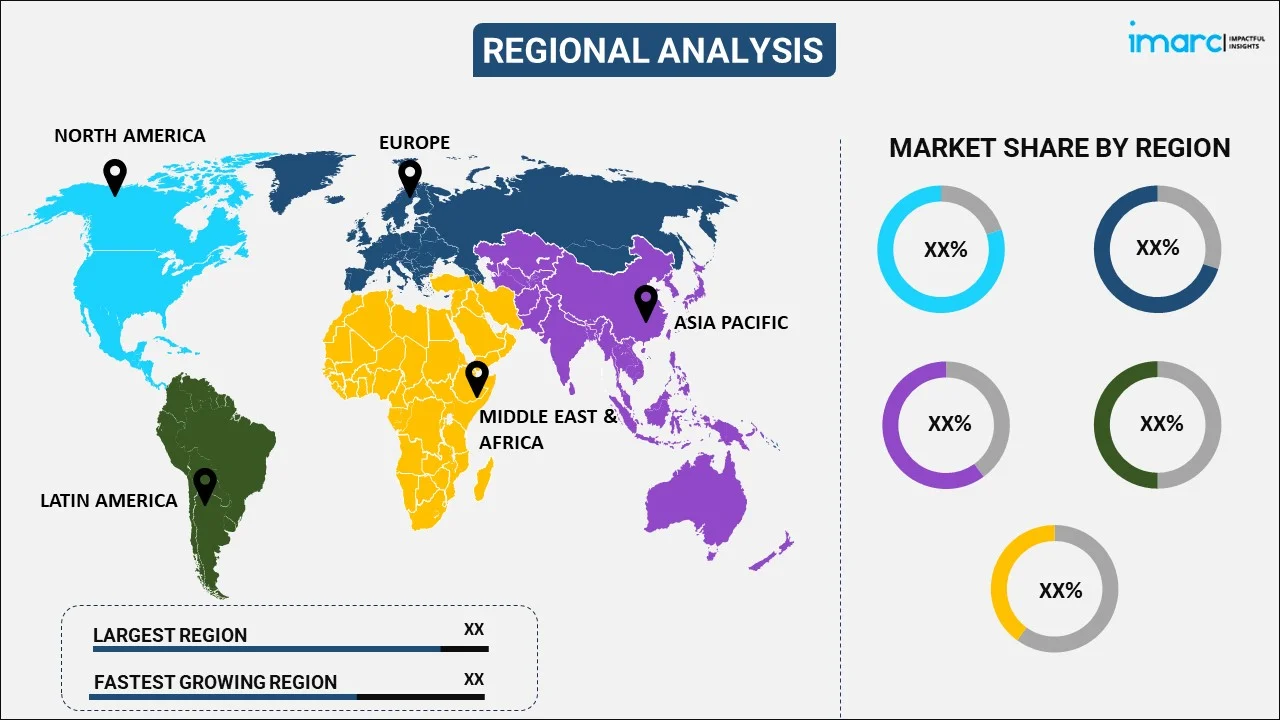
Construction Composites Market by Fiber Type (Carbon Fiber, Glass Fiber, and Others), Resin Type (Thermoplastic, Thermoset), End Use (Industrial, Commercial, Residential), and Region 2025-2033
Market Overview:
The global construction composites market size reached USD 5.8 Billion in 2024. Looking forward, IMARC Group expects the market to reach USD 8.2 Billion by 2033, exhibiting a growth rate (CAGR) of 3.96% during 2025-2033. Increasing usage of composites in construction applications, rehabilitation of old concrete structures, and high installation costs of composites represent some of the key factors driving the market.
|
Report Attribute
|
Key Statistics
|
|---|---|
|
Base Year
|
2024
|
|
Forecast Years
|
2025-2033
|
|
Historical Years
|
2019-2024
|
|
Market Size in 2024
|
USD 5.8 Billion |
|
Market Forecast in 2033
|
USD 8.2 Billion |
| Market Growth Rate 2025-2033 | 3.96% |
Construction composites refer to a class of materials made of two or more constituent materials, which when combined, exhibit superior properties to the individual components. These materials are generally used in the construction due to their strength, durability, and resistance to harsh environmental conditions. The composites can be made up of various materials, including fibers, resins, and fillers, which are mixed in precise ratios to produce the desired properties. Some common types of construction composites include fiberglass, carbon fiber-reinforced polymer, and polymer concrete. These materials can be used in a variety of applications, including bridges, buildings, and pipelines, to improve the performance and durability of the structures. In recent years, construction composites have gained momentum as they offer lightweight, high-strength, and durable solutions for construction projects that require high-performance materials.

Construction Composites Market Trends:
One of the primary factors driving the market is the augmenting demand for lightweight and high-strength materials in the construction industry. Additionally, due to the high strength-to-weight ratio construction composites are widely used for applications, where weight reduction is critical, such as automotive, aerospace, and wind energy industries, thus creating a positive market outlook. Other than this, the increasing environmental awareness and concerns for sustainability and eco-friendliness have encouraged individuals to opt for green and sustainable construction Composites, which are made from recycled materials and reduce waste and energy consumption. Additionally, composites are lightweight and more energy-efficient than traditional materials, resulting in reduced carbon emissions during the construction process. Besides this, the rising demand for corrosion-resistant materials in harsh environments, such as chemical and marine processing, is positively influencing the market growth. Apart from this, there has been a rise in civil construction which comprises of roads, airports, bridges, buildings, and related structures. As a result, construction composites are widely used for the rehabilitation of old concrete structures as they have better acoustic and thermal insulation properties. Furthermore, key players are extensively investing in research and development (R&D) activities in order to expand their consumer base. Moreover, technological advancements in the construction composites industry, such as better manufacturing procedures, development of new materials, and the introduction of new applications, are anticipated to create a positive market outlook in the coming years.
Key Market Segmentation:
IMARC Group provides an analysis of the key trends in each segment of the global construction composites market, along with forecasts at the global, regional, and country levels from 2025-2033. Our report has categorized the market based on fiber type, resin type, and end use.
Fiber Type Insights:

- Carbon Fiber
- Glass Fiber
- Others
The report has provided a detailed breakup and analysis of the construction composites market based on the fiber type. This includes carbon fiber, glass fiber, and others. According to the report, carbon fiber represented the largest segment.
Resin Type Insights:
- Thermoplastic
- Thermoset
A detailed breakup and analysis of the construction composites market based on the resin type has also been provided in the report. This includes thermoplastic and thermoset. According to the report, thermoset accounted for the largest market share.
End Use Insights:
- Industrial
- Commercial
- Residential
The report has provided a detailed breakup and analysis of the construction composites market based on the end use. This includes industrial, commercial, and residential. According to the report, industrial sector held the majority of the overall market share.
Regional Insights:

- North America
- United States
- Canada
- Europe
- Germany
- France
- United Kingdom
- Italy
- Spain
- Russia
- Others
- Asia Pacific
- China
- Japan
- India
- South Korea
- Australia
- Indonesia
- Others
- Latin America
- Brazil
- Mexico
- Others
- Middle East and Africa
The report has also provided a comprehensive analysis of all the major regional markets, which include North America (the United States and Canada); Europe (Germany, France, the United Kingdom, Italy, Spain, Russia, and others); Asia Pacific (China, Japan, India, South Korea, Australia, Indonesia, and others); Latin America (Brazil, Mexico, and others); and the Middle East and Africa. According to the report, Asia Pacific was the largest market for construction composites. Some of the factors driving the Asia Pacific construction composites market included significant growth in the construction industry, increasing infrastructure projects, including bridges and roads, several initiatives undertaken by government promoting green construction, etc.
Competitive Landscape:
The report has also provided a comprehensive analysis of the competitive landscape in the global construction composites market. Competitive analysis such as market structure, market share by key players, player positioning, top winning strategies, competitive dashboard, and company evaluation quadrant has been covered in the report. Also, detailed profiles of all major companies have been provided. Some of the companies covered include Aegion Corporation, Bedford Reinforced Plastics, Exel Composites Oyj, Fibergrate Composite Structures Incorporated (RPM International Inc.), Gurit Holding AG, Jiangsu Jiuding New Material Company Ltd., Owens Corning, Schock Bauteile GmbH, SGL Carbon SE, Strongwell Corporation, UPM Biocomposites, etc. Kindly note that this only represents a partial list of companies, and the complete list has been provided in the report.
Report Coverage:
| Report Features | Details |
|---|---|
| Base Year of the Analysis | 2024 |
| Historical Period | 2019-2024 |
| Forecast Period | 2025-2033 |
| Units | Billion USD |
| Fiber Types Covered | Carbon Fiber, Glass Fiber, Others |
| Resin Types Covered | Thermoplastic, Thermoset |
| End Uses Covered | Industrial, Commercial, Residential |
| Regions Covered | Asia Pacific, Europe, North America, Latin America, Middle East and Africa |
| Countries Covered | United States, Canada, Germany, France, United Kingdom, Italy, Spain, Russia, China, Japan, India, South Korea, Australia, Indonesia, Brazil, Mexico |
| Companies Covered | Aegion Corporation, Bedford Reinforced Plastics, Exel Composites Oyj, Fibergrate Composite Structures Incorporated (RPM International Inc.), Gurit Holding AG, Jiangsu Jiuding New Material Company Ltd., Owens Corning, Schock Bauteile GmbH, SGL Carbon SE, Strongwell Corporation, UPM Biocomposites, etc. |
| Customization Scope | 10% Free Customization |
| Post-Sale Analyst Support | 10-12 Weeks |
| Delivery Format | PDF and Excel through Email (We can also provide the editable version of the report in PPT/Word format on special request) |
Key Benefits for Stakeholders:
- IMARC’s report offers a comprehensive quantitative analysis of various market segments, historical and current market trends, market forecasts, and dynamics of the construction composites from 2019-2033.
- The research study provides the latest information on the market drivers, challenges, and opportunities in the global construction composites market.
- The study maps the leading, as well as the fastest-growing, regional markets. It further enables stakeholders to identify the key country-level markets within each region.
- Porter's five forces analysis assist stakeholders in assessing the impact of new entrants, competitive rivalry, supplier power, buyer power, and the threat of substitution. It helps stakeholders to analyze the level of competition within the construction composites industry and its attractiveness.
- Competitive landscape allows stakeholders to understand their competitive environment and provides an insight into the current positions of key players in the market.
Key Questions Answered in This Report
The global construction composites market was valued at USD 5.8 Billion in 2024.
We expect the global construction composites market to exhibit a CAGR of 3.96% during 2025-2033.
The rising consumer environmental concerns regarding sustainability and eco-friendliness for green and sustainable construction composites that are made from recycled materials and reduced waste, energy consumption, and carbon emissions during the construction process, are primarily driving the global construction composites market.
The sudden outbreak of the COVID-19 pandemic had led to the implementation of stringent lockdown regulations across several nations resulting in the temporary halt of numerous construction activities, thereby negatively impacting the global market for construction composites.
Based on the fiber type, the global construction composites market can be segmented into carbon fiber, glass fiber, and others. Currently, carbon fiber accounts for the majority of the global market share.
Based on the resin type, the global construction composites market has been categorized into thermoplastic and thermoset, where thermoset currently exhibits a clear dominance in the market.
Based on the end use, the global construction composites market can be segregated industrial, commercial, and residential. Currently, industrial holds the largest market share.
On a regional level, the market has been classified into North America, Europe, Asia Pacific, Latin America, and Middle East and Africa, where Asia Pacific currently dominates the global market.
Some of the major players in the global construction composites market include Aegion Corporation, Bedford Reinforced Plastics, Exel Composites Oyj, Fibergrate Composite Structures Incorporated (RPM International Inc.), Gurit Holding AG, Jiangsu Jiuding New Material Company Ltd., Owens Corning, Schock Bauteile GmbH, SGL Carbon SE, Strongwell Corporation, UPM Biocomposites, etc.
Need more help?
- Speak to our experienced analysts for insights on the current market scenarios.
- Include additional segments and countries to customize the report as per your requirement.
- Gain an unparalleled competitive advantage in your domain by understanding how to utilize the report and positively impacting your operations and revenue.
- For further assistance, please connect with our analysts.
 Inquire Before Buying
Inquire Before Buying
 Speak to an Analyst
Speak to an Analyst
 Request Brochure
Request Brochure
 Request Customization
Request Customization




.webp)




.webp)












